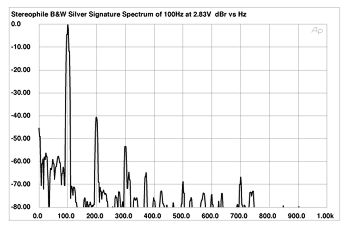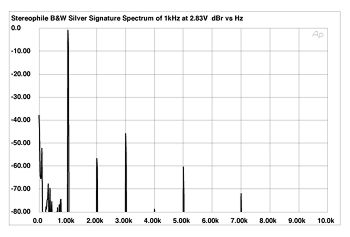| Columns Retired Columns & Blogs |
B&W John Bowers Silver Signature loudspeaker Measurements part 4
Because I review the very-low-distortion Velodyne DF-661 in this issue, the levels of the B&W Silver Signature's individual harmonics are given in Table 1. (Note that I've listed the speaker's impedance magnitude at each of the test frequencies. This is because the 2.83V and 8.95V voltage levels I used will only be equivalent to 1W and 10W power levels if the impedance is exactly 8 ohms.)
Table 1: Distortion Harmonic Levels in dB ref. Fundamental Level
| Frequency (Impedance) | Drive Power | 2nd | 3rd | 4th | 5th |
| 100Hz (11.9 ohms) | 2.83V 0.67W | -40.5 | -53.3 | -75.7 | -68.6 |
| 8.95V 6.7W | -31.0 | -40.0 | -57.6 | -62.1 | |
| 1kHz (31.2 ohms) | 2.83V 0.26W | -55.8 | -45.0 | -78.0 | -59.6 |
| 8.95V 2.58W | -45.3 | -35.2 | -59.5 | -67.0 |
Fig.14 shows the spectrum of the B&W Silver Signature reproducing a 100Hz tone at 2.83V. The second harmonic here reaches the -40dB level, or 1%. Drive-unit distortion is related to diaphragm excursion, which will be lower at high frequencies. Increasing the drive-signal frequency should therefore result in lower levels of distortion. This can be seen in the table and in fig.15. The B&W's predominant harmonic, the third at 3kHz, an octave-and-a-fifth above the fundamental, lies at around 0.5%, which is more than 20dB higher in level than the DF-661's; I found it to be just audible with the pure tone. (Note that, by conventional loudspeaker standards, this distortion is still quite low.)

Fig.14 B&W Silver Signature, spectrum of 100Hz sinewave, DC-1kHz, 2.83V drive signal (linear frequency scale, 10dB vertical div.).

Fig.15 B&W Silver Signature, spectrum of 1kHz sinewave, DC-10kHz, 2.83V drive signal (linear frequency scale, 10dB vertical div.).
Finally, I attached a simple accelerometer to the center of the enclosure's side panel while the loudspeaker was being driven by high-level, 2kHz-bandwidth MLS noise. A waterfall plot of the accelerometer's output (not shown) revealed that the primary resonance of the Matrix cabinet lies at a high 443Hz. This is almost exactly the frequency of the A above Middle C, which means that it will be almost continually excited by music. It could be easily heard with a stethoscope pressed against the enclosure panels, but it was harder to attribute anything I heard in my normal auditioning to this mode. Probing around the top panel with the 'scope, I could hear an 800Hz mode as a distinct whistle at a couple of very specific places. Though this is suspiciously the same frequency as the response and impedance anomalies noted earlier, it didn't show up on the accelerometer tests.
The improvement I heard brought about by the Combak Harmonix dots leads me to suspect that the slight lack of midrange clarity might be associated with these cabinet problems, but that will have to await further investigation—this review is rapidly filling its allotted space.—John Atkinson
- Log in or register to post comments




































